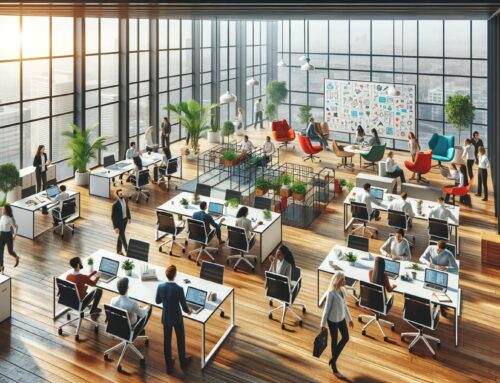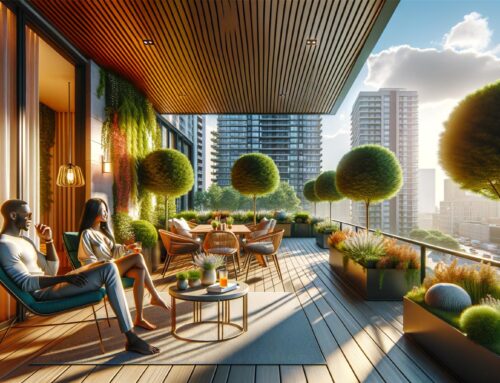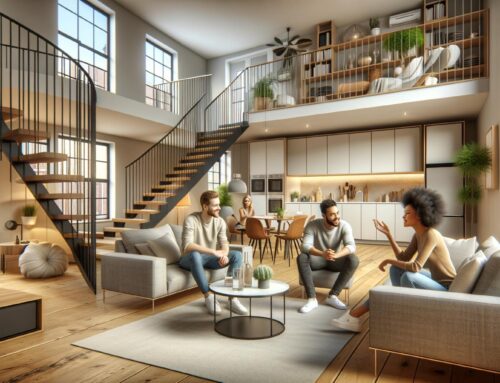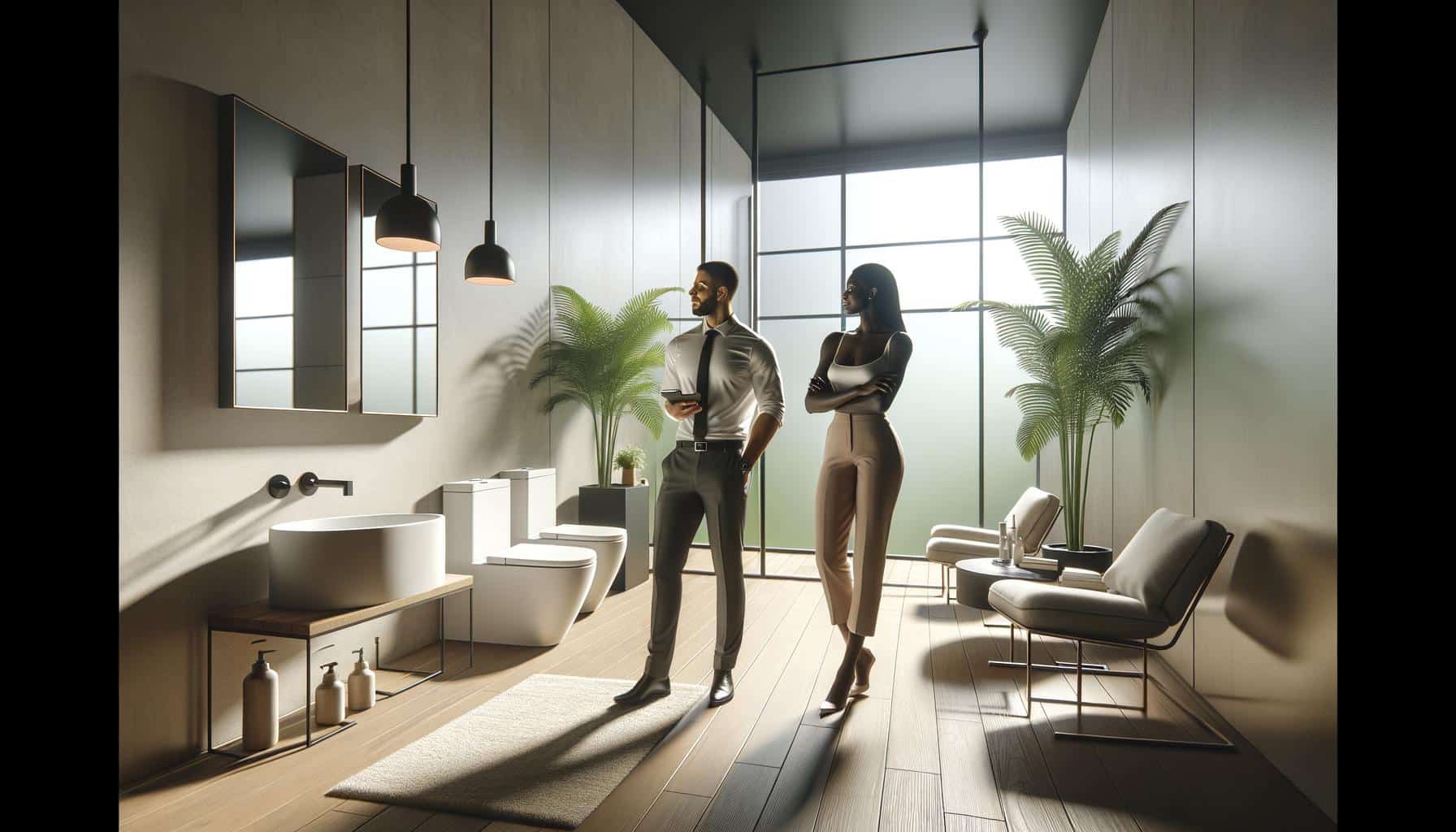
At Home Owners Association, we understand the impact a well-designed bathroom can have on your home’s comfort and value.
Toilet renovation ideas are often overlooked, yet they can significantly transform your bathroom experience.
In this post, we’ll explore practical ways to upgrade your toilet area, from modern designs to eco-friendly options.
How to Assess Your Bathroom for Renovation
Measure and Map Your Space
Start with precise measurements of your bathroom. Record the dimensions of the room, including the locations of windows, doors, and existing fixtures. This information will help you visualise potential changes and ensure new fixtures will fit properly. Don’t overlook the space around your toilet – you’ll need at least 60 cm of clearance in front and 40 cm on each side for comfort (and compliance with most building codes).
Identify Your Pain Points
Create a list of what doesn’t work in your current bathroom. Is the toilet too close to the sink? Does the door swing awkwardly? Is there a lack of storage? These issues will guide your renovation priorities. For instance, if space is tight, you might consider a wall-hung toilet to free up floor area. Recent statistics show that about one in every three households across Australia took on a renovation in 2025.
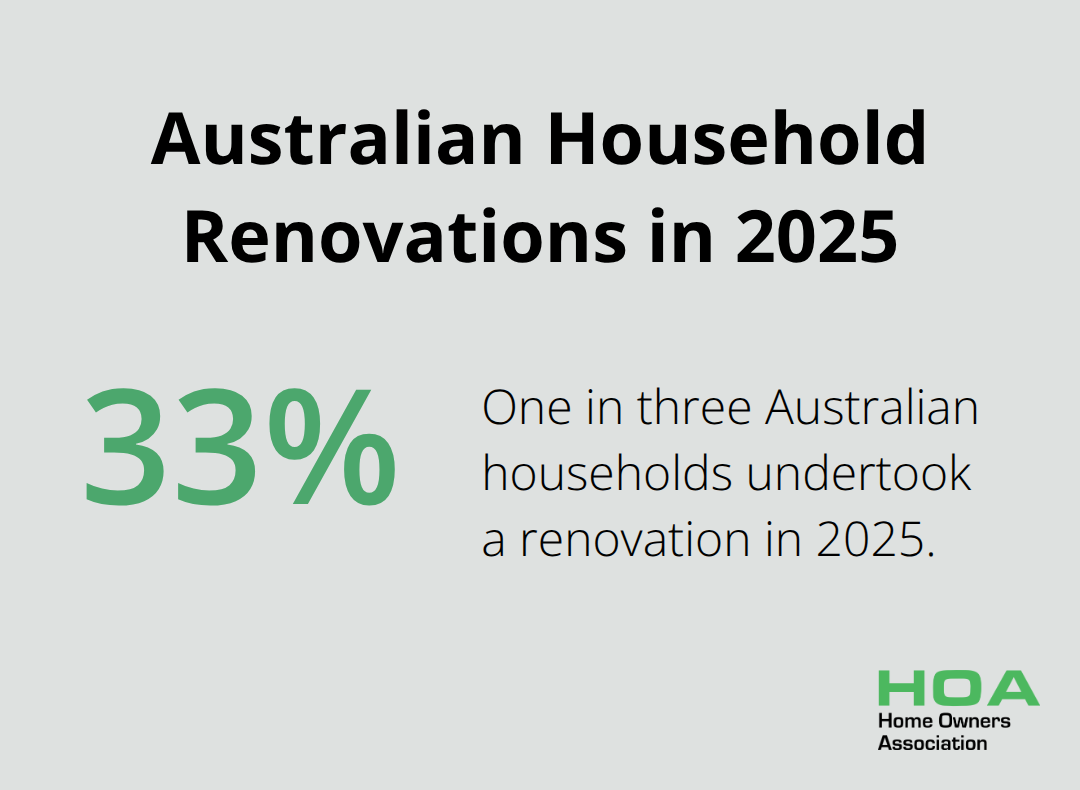
Check Your Plumbing
Examine the condition and location of your plumbing. Moving plumbing can significantly increase costs, so it’s often more budget-friendly to work with existing connections. However, if your pipes are old or show signs of wear, now’s the time to update them. The Australian Bureau of Statistics reports that homes over 30 years old are more likely to need plumbing upgrades during renovations.
Set a Realistic Budget
Bathroom renovations can vary widely in cost. According to recent data, bathroom renovation costs range from $8000 to over $35000. Try to allocate about 20-30% of your budget for the toilet area, including fixtures and installation.
Factor in unexpected costs. It’s wise to set aside an additional 10-20% of your total budget for unforeseen expenses (like water damage repair or structural issues that might be uncovered during the renovation process).
This thorough assessment of your space, identification of problem areas, and clear budget setting will prepare you for the next exciting phase: exploring modern toilet design trends that can transform your bathroom experience.
Modern Toilet Design Trends
At Home Owners Association, we’ve observed a significant shift in toilet design trends over the past few years. Homeowners now seek toilets that not only fulfil their basic function but also enhance the overall bathroom experience. Let’s explore some of the most popular trends that transform Australian bathrooms.
Wall-Hung Toilets: Space-Saving Marvels
Wall-hung toilets have become a game-changer in bathroom design. These fixtures mount directly to the wall, with the tank concealed behind it. This design creates the illusion of more floor space, making even compact bathrooms appear larger while offering premium functionality.
The benefits extend beyond aesthetics. Wall-hung toilets are easier to clean around and under, improving hygiene. They also allow for height adjustment during installation, enabling customisation to suit different family members’ needs.
Smart Toilets: The Future is Now
Smart toilets rapidly gain popularity in Australian homes. These high-tech fixtures offer a range of features that elevate comfort and hygiene. Some of the most sought-after features include:
- Automatic lid opening and closing
- Heated seats with temperature control
- Built-in bidets with adjustable water pressure
- Self-cleaning functions
- Nightlights for easy night-time use
While they come with a higher initial cost, many homeowners find the long-term benefits in comfort and hygiene worth the investment.
Eco-Friendly Options: Water and Money Savers
Water conservation is a top priority for many Australian homeowners. The latest toilet designs reflect this concern, offering water-efficient options that don’t compromise on performance. Dual-flush toilets (which have been standard in Australia for years) continue to evolve with even more efficient models.
The Water Efficiency Labelling and Standards (WELS) scheme helps consumers identify the most water-efficient products.
Some innovative designs go even further. Vacuum-assisted flush systems, for instance, use air pressure to enhance flushing power while using less water. These systems can reduce water usage compared to standard toilets.
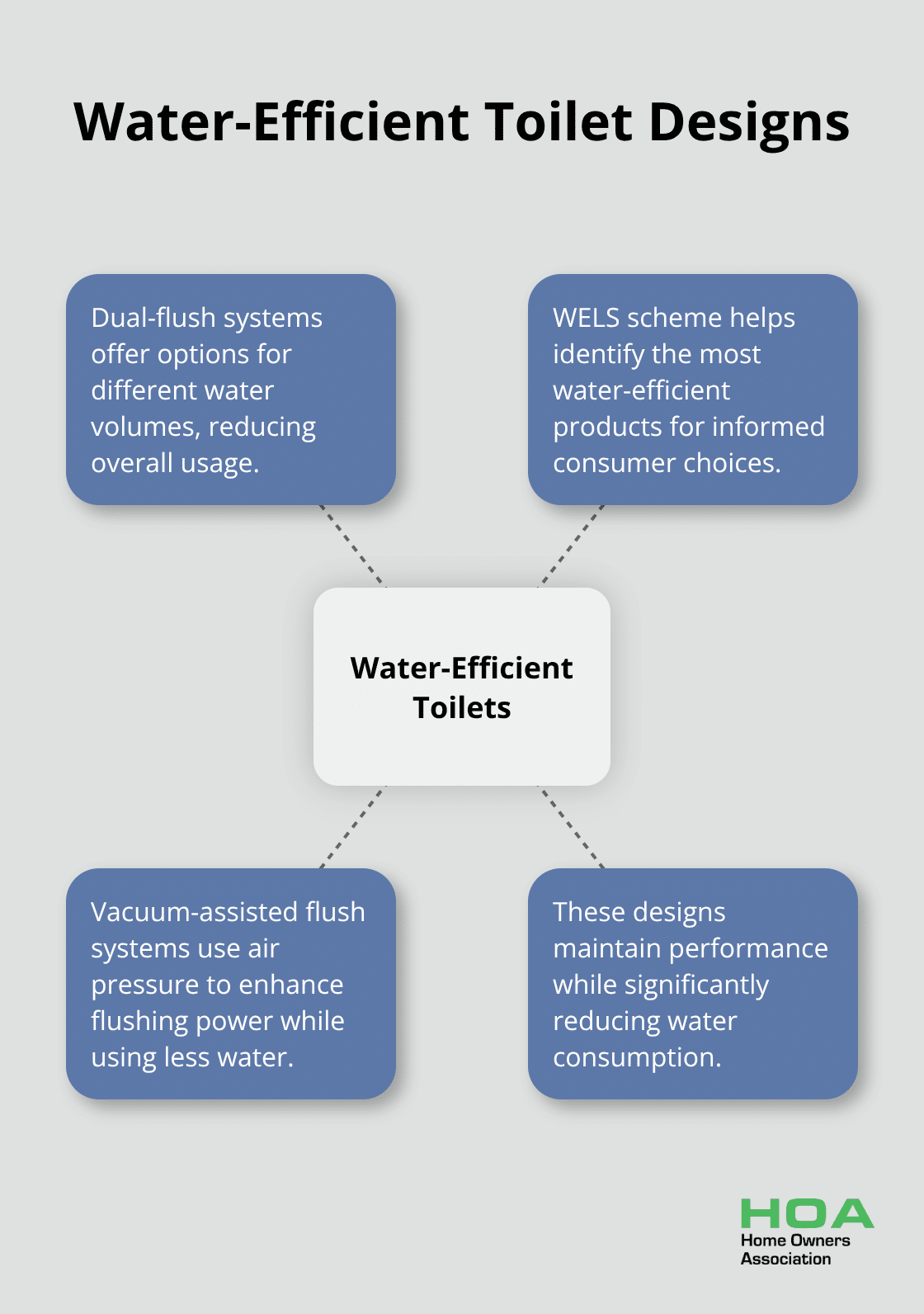
As you consider these modern toilet design trends for your renovation, keep in mind that the right choice depends on your specific needs, budget, and bathroom layout. In the next section, we’ll explore practical toilet renovation ideas that can help you implement these trends in your own home.
Practical Toilet Upgrades for Your Renovation
At Home Owners Association, we have witnessed numerous toilet renovations. We know that practical upgrades can transform your bathroom experience. Let’s explore some cost-effective and impactful changes you can implement in your bathroom.
Dual-Flush Systems: Water-Saving Powerhouses
Dual-flush toilets are a smart addition to any renovation. Modern toilets with a dual-flush system offer a more water-efficient option than a traditional single-flush, reducing household water usage.
A professional plumber can install a dual-flush system in less than two hours. Costs range from $150 to $800 for the toilet itself, with installation adding another $200 to $400. The long-term savings on water bills make this an investment that pays for itself over time.
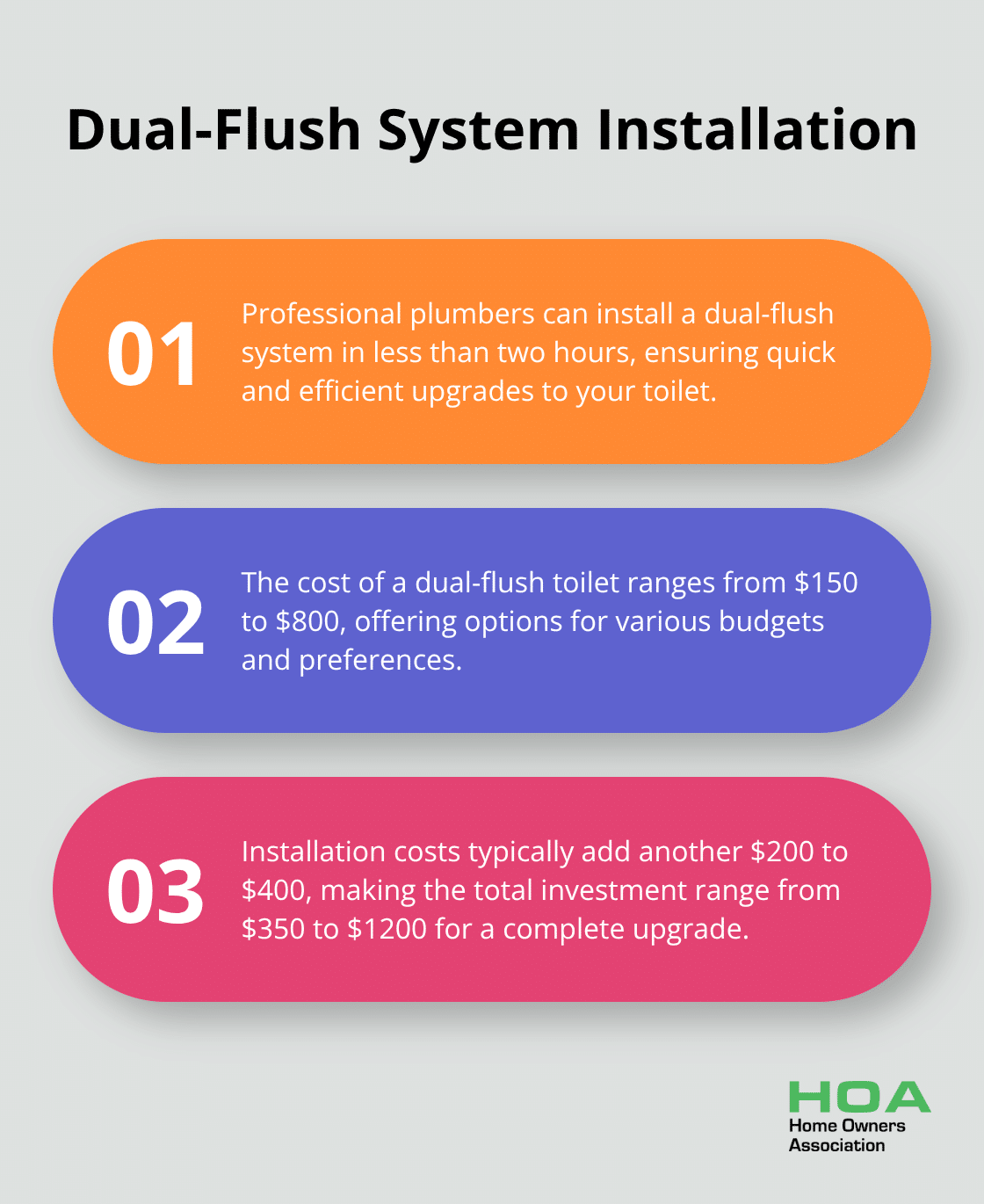
Bidet Attachments: Hygiene Boosters
Bidets are becoming increasingly popular in Australia. They offer superior hygiene, reduce toilet paper usage, and can be gentler on sensitive skin. A bidet attachment is an affordable way to add this feature without replacing your entire toilet.
Quality bidet attachments range from $50 to $200 and can be installed easily. They connect to your existing water supply and fit under your current toilet seat. Some models offer adjustable water pressure and temperature control for added comfort.
Lighting: Illuminating Comfort
Proper lighting is essential for a comfortable toilet area. Poor lighting can make the space feel cramped and uninviting. Consider installing LED strip lights under the toilet rim or along the baseboards. These provide subtle illumination without harsh overhead glare. Costs start at around $30 for a basic kit.
Ventilation: Freshness Factors
Inadequate ventilation can lead to moisture problems and unpleasant odours. Upgrade to a more powerful exhaust fan to improve your bathroom’s air quality. Look for models with a CFM (cubic feet per minute) rating appropriate for your bathroom size. As a rule of thumb, you need 1 CFM per square foot of bathroom area. A good quality fan typically costs between $100 and $300, plus installation.
These practical upgrades can significantly enhance your toilet area’s functionality, efficiency, and comfort. While DIY installation is possible for some of these improvements, professional installation ensures safety and optimal performance (especially for electrical and plumbing work).
Wrapping Up
Toilet renovation ideas transform bathrooms into functional and aesthetically pleasing spaces. Wall-hung toilets save space, smart toilets offer advanced features, and eco-friendly options conserve water. These upgrades not only enhance comfort but also increase home value and reduce utility bills (a win-win for homeowners).
Professional installation ensures that toilet renovations meet local building codes and prevent potential issues. This is particularly important for plumbing and electrical work, where mistakes can lead to costly damages. Expert installers complete the work to the highest standards, providing peace of mind for homeowners.
We at Home Owners Association recommend considering these toilet renovation ideas for your next bathroom project. A well-designed toilet space creates a more comfortable living environment and future-proofs your bathroom. The long-term benefits of a thoughtful renovation extend far beyond mere aesthetics, making it a worthwhile investment in your home’s future.

